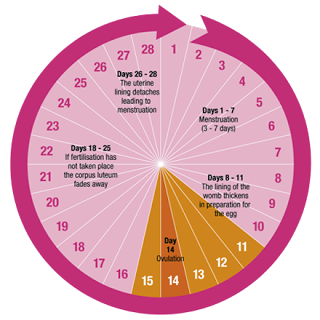Currently, I am on CD19. My last menstrual period was a breeze compared to the last few. Hardly any cramps, and if I did have them they were not severe. This last menstruation wasn’t heavy either.
Thank God! I will continue taking the progesterone cream I
reviewed last week since it seems to be helping. Oh, and my cousin suggested I try black currant oil because it is supposed to “work wonders for cramps.” I will try that next. I have not yet started up the progesterone cream again
because I need to start after I ovulate, which is a little bit of a pain in the butt.
As I mentioned last week, you have to stop applying the
progesterone cream the day you start your menstruation, and then begin again after you ovulate. Starting before you ovulate will prevent ovulation from occurring for that cycle. If you don’t know when you ovulate there are several ways you can figure it out. The most important part of figuring when you ovulate and menstruate is knowing how long your cycle and luteal phases are. It helps to know if you’re trying to prevent pregnancy or get pregnant. This way you don’t have to rely on the “pull and pray” method
Here are ways you can figure out when you ovulate
- Purchase an Ovulation Prediction Kit (OPK) or test strips
- Check your cervical mucus
- Chart your basal body temperature
I currently used to use the
Wondfo one-step ovulation (LH) test strips; however, I began to use
Clearblue Advanced Digital Ovulation test. They’re easy to use and they’re affordable. I purchased mine from
Amazon. I also have the iPeriod app on my phone If you want me to review it in a later post I an, just let me know. I can also tell when I’m about to ovulate because I get a crazy amount of egg white cervical mucus (EWCM) around the time.
Changes in your Cervical Mucus
As the levels of estrogen increase the cervical mucus becomes clearer, wetter and thinner, when the estrogen levels peak (just prior to ovulation) the cervical mucus becomes jelly like, pliable and elastic or stretchable, resembling raw egg white, hence the term EWCM.
Note: not all women experience this kind of mucus. At the time of ovulation, the wet cervical mucus stops.
Ovulation occurs (with 85% of women) on the day the wet or EWCM ceases, and (with 10% of
women) the day after the EWCM has ceased. The clear, thin, wet mucus is produced up to 6 days prior to ovulation, this is fertile mucus. The EWCM is produced immediately prior to ovulation, this is highly fertile mucus.
Your cervical mucus changes with the levels of hormone present in the blood stream. Early in the follicular phase cervical mucus is non-existent or it is sticky, tacky, and often white, yellow or opaque in appearance.
Sperm cannot live in an environment free from fertile mucus but can survive for up to 3-5 days in the nourishing environment this cervical mucus provides. The average life span of a healthy sperm is between 18 -72 hours however some are still viable for up to 5 days. This means, avoid unprotected sex during this time if you’re trying to prevent pregnancy. However, if you’re trying to get pregnant, it’s best to have sex every two to three days throughout your cycle (NCCWCH 2004:27). It’s more effective than having sex only on the days you think you’re about to ovulate. Also, sex every two to three days improves the quality of sperm when compared with daily sex (NCCWCH 2004: 27).
Charting Basal Body Temperature
Charting basal body temperature is something I did but stopped doing. Through research, I’ve found
that if you’re trying to catch ovulation, this is pretty much pointless because it only lets you know you’ve ovulated AFTER it has occurred. You will not be able to predict your ovulation day until after several cycles.
Before ovulation, a woman’s basal body temperature is usually about 97.0 to 97.5 degrees Fahrenheit, although those numbers can vary from person to person. During ovulation, your body releases the hormone progesterone, which results in a slightly raised temperature a day or two after ovulation — usually by 0.1 or 0.2 degrees.
Do you chart your menstrual cycle?
Disclaimer: Information in this post should not be considered medical advice. My experience may not reflect that of your own. If you’re experiencing any of these symptoms, please speak with your healthcare provider before starting any supplements. Affiliate Links.

